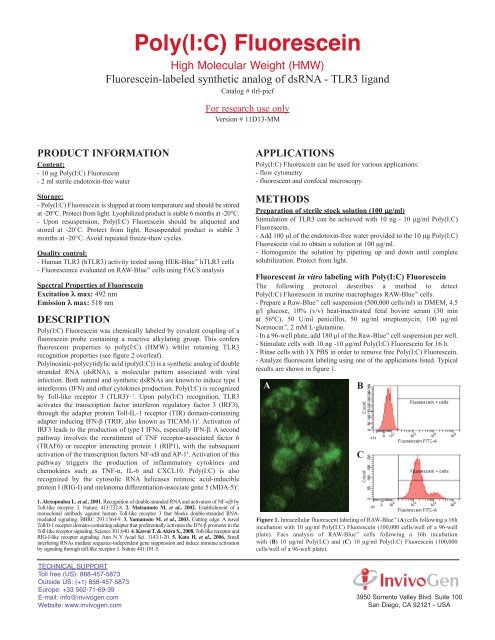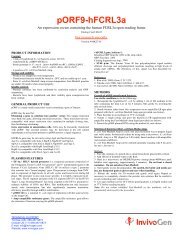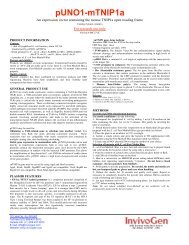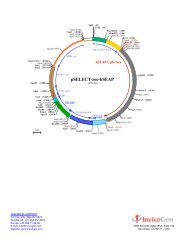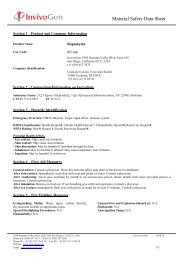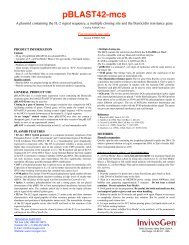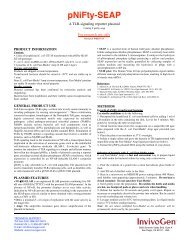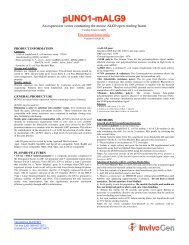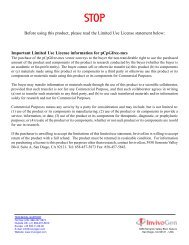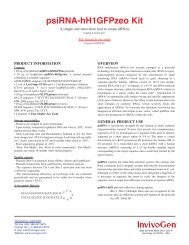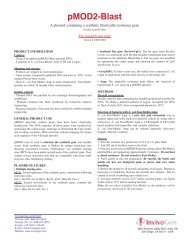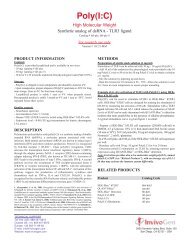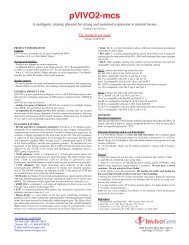Poly(I:C) Fluorescein - InvivoGen
Poly(I:C) Fluorescein - InvivoGen
Poly(I:C) Fluorescein - InvivoGen
You also want an ePaper? Increase the reach of your titles
YUMPU automatically turns print PDFs into web optimized ePapers that Google loves.
<strong>Poly</strong>(I:C) <strong>Fluorescein</strong><br />
High Molecular Weight (HMW)<br />
<strong>Fluorescein</strong>-labeled synthetic analog of dsRNA - TLR3 ligand<br />
Catalog # tlrl-picf<br />
For research use only<br />
Version # 11D13-MM<br />
PrODuCT INFOrMATION<br />
Content:<br />
- 10 mg <strong>Poly</strong>(I:C) <strong>Fluorescein</strong><br />
- 2 ml sterile endotoxin-free water<br />
Storage:<br />
- <strong>Poly</strong>(I:C) <strong>Fluorescein</strong> is shipped at room temperature and should be stored<br />
at -20°C. Protect from light. Lyophilized product is stable 6 months at -20°C.<br />
- Upon resuspension, <strong>Poly</strong>(I:C) <strong>Fluorescein</strong> should be aliquoted and<br />
stored at -20˚C. Protect from light. Resuspended product is stable 3<br />
months at -20°C. Avoid repeated freeze-thaw cycles.<br />
Quality control:<br />
- Human TLR3 (hTLR3) activity tested using HEK-Blue hTLR3 cells<br />
- Fluorescence evaluated on RAW-Blue cells using FACS analysis<br />
Spectral Properties of <strong>Fluorescein</strong><br />
Excitation l max: 492 nm<br />
Emission l max: 518 nm<br />
DESCrIPTION<br />
<strong>Poly</strong>(I:C) <strong>Fluorescein</strong> was chemically labeled by covalent coupling of a<br />
fluorescein probe containing a reactive alkylating group. This confers<br />
fluorescent properties to poly(I:C) (HMW) whilst retaining TLR3<br />
recognition properties (see figure 2 overleaf).<br />
<strong>Poly</strong>inosinic-polycytidylic acid (poly(I:C)) is a synthetic analog of double<br />
stranded RNA (dsRNA), a molecular pattern associated with viral<br />
infection. Both natural and synthetic dsRNAs are known to induce type I<br />
interferons (IFN) and other cytokines production. <strong>Poly</strong>(I:C) is recognized<br />
by Toll-like receptor 3 (TLR3) 1, 2 . Upon poly(I:C) recognition, TLR3<br />
activates the transcription factor interferon regulatory factor 3 (IRF3),<br />
through the adapter protein Toll-IL-1 receptor (TIR) domain-containing<br />
adapter inducing IFN-β (TRIF, also known as TICAM-1) 3 . Activation of<br />
IRF3 leads to the production of type I IFNs, especially IFN-β. A second<br />
pathway involves the recruitment of TNF receptor-associated factor 6<br />
(TRAF6) or receptor interacting protein 1 (RIP1), with the subsequent<br />
activation of the transcription factors NF-κB and AP-1 4 . Activation of this<br />
pathway triggers the production of inflammatory cytokines and<br />
chemokines such as TNF-α, IL-6 and CXCL10. <strong>Poly</strong>(I:C) is also<br />
recognized by the cytosolic RNA helicases retinoic acid-inducible<br />
protein I (RIG-I) and melanoma differentiation-associate gene 5 (MDA-5) 5 .<br />
1. Alexopoulou L. et al., 2001. Recognition of double-stranded RNA and activation of NF-kB by<br />
Toll-like receptor 3. Nature, 413:732-8. 2. Matsumoto M. et al., 2002. Establishment of a<br />
monoclonal antibody against human Toll-like receptor 3 that blocks double-stranded RNAmediated<br />
signaling. BBRC 293:1364-9. 3. Yamamoto M. et al., 2003. Cutting edge: A novel<br />
Toll/Il-1 receptor domain-containing adapter that preferentially activates the IFN-β promoter in the<br />
Toll-like receptor signaling. Science 301:640. 4. Kawai T. & Akira S., 2008. Toll-like receptor and<br />
RIG-I-like receptor signaling. Ann N Y Acad Sci. 1143:1-20. 5. Kato H. et al., 2006. Small<br />
interfering RNAs mediate sequence-independent gene suppression and induce immune activation<br />
by signaling through toll-like receptor 3. Nature 441:101-5.<br />
APPLICATIONS<br />
<strong>Poly</strong>(I:C) <strong>Fluorescein</strong> can be used for various applications:<br />
- flow cytometry<br />
- fluorescent and confocal microscopy.<br />
METHODS<br />
Preparation of sterile stock solution (100 mg/ml)<br />
Stimulation of TLR3 can be achieved with 10 ng - 10 µg/ml <strong>Poly</strong>(I:C)<br />
<strong>Fluorescein</strong>.<br />
- Add 100 ml of the endotoxin-free water provided to the 10 mg <strong>Poly</strong>(I:C)<br />
<strong>Fluorescein</strong> vial to obtain a solution at 100 mg/ml.<br />
- Homogenize the solution by pipetting up and down until complete<br />
solubilization. Protect from light.<br />
Fluorescent in vitro labeling with <strong>Poly</strong>(I:C) <strong>Fluorescein</strong><br />
The following protocol describes a method to detect<br />
<strong>Poly</strong>(I:C) <strong>Fluorescein</strong> in murine macrophages RAW-Blue cells.<br />
- Prepare a Raw-Blue cell suspension (500,000 cells/ml) in DMEM, 4.5<br />
g/l glucose, 10% (v/v) heat-inactivated fetal bovine serum (30 min<br />
at 56ºC), 50 U/ml penicillin, 50 mg/ml streptomycin, 100 mg/ml<br />
Normocin , 2 mM L-glutamine.<br />
- In a 96-well plate, add 180 µl of the Raw-Blue cell suspension per well.<br />
- Stimulate cells with 10 ng -10 μg/ml <strong>Poly</strong>(I:C) <strong>Fluorescein</strong> for 16 h.<br />
- Rinse cells with 1X PBS in order to remove free <strong>Poly</strong>(I:C) <strong>Fluorescein</strong>.<br />
- Analyze fluorescent labeling using one of the applications listed. Typical<br />
results are shown in figure 1.<br />
A<br />
Figure 1. Intracellular fluorescent labeling of RAW-Blue (A) cells following a 16h<br />
incubation with 10 mg/ml <strong>Poly</strong>(I:C) <strong>Fluorescein</strong> (100,000 cells/well of a 96-well<br />
plate). Facs analysis of RAW-Blue cells following a 16h incubation<br />
with (B) 10 mg/ml <strong>Poly</strong>(I:C) and (C) 10 mg/ml <strong>Poly</strong>(I:C) <strong>Fluorescein</strong> (100,000<br />
cells/well of a 96-well plate).<br />
B<br />
C<br />
TECHNICAL SUPPORT<br />
Toll free (US): 888-457-5873<br />
Outside US: (+1) 858-457-5873<br />
Europe: +33 562-71-69-39<br />
E-mail: info@invivogen.com<br />
Website: www.invivogen.com<br />
3950 Sorrento Valley Blvd. Suite 100<br />
San Diego, CA 92121 - USA
TLr3 activation with <strong>Poly</strong>(I:C) <strong>Fluorescein</strong><br />
<strong>Poly</strong>(I:C) <strong>Fluorescein</strong>-induced TLR3 activation can be monitored using<br />
TLR3 reporter cell lines, such as HEK-Blue hTLR3 cells.<br />
HEK-Blue -hTLR3 cells are designed for studying the stimulation of hTLR3<br />
by monitoring the activation of NF-kB. These cells were transfected with the<br />
human TLR3 gene and an NF-kB/AP-1-inducible SEAP (secreted alkaline<br />
phosphatase) reporter gene. Levels of SEAP can be easily determined with<br />
QUANTI-Blue (a detection medium that turns purple/blue in the presence of<br />
alkaline phosphatase). Alternatively, HEK-Blue Detection, a cell culture<br />
medium that allows for real-time detection of SEAP can be used. A typical<br />
stimulation curve obtained with QUANTI-Blue is given in figure 2.<br />
- Prepare a HEK-Blue hTLR3 cell suspension (250,000 cells/ml) in<br />
DMEM, 4.5 g/l glucose, 10% (v/v) heat-inactivated fetal bovine serum (30<br />
min at 56ºC), 50 U/ml penicillin, 50 mg/ml streptomycin, 100 mg/ml<br />
Normocin , 2 mM L-glutamine.<br />
- In a 96-well plate, add 180 µl of the HEK-Blue hTLR3 cell suspension<br />
per well.<br />
- Stimulate cells with 10 ng -10 μg/ml <strong>Poly</strong>(I:C) <strong>Fluorescein</strong> for 6 to 24 h.<br />
- Determine <strong>Poly</strong>(I:C) <strong>Fluorescein</strong> stimulation on TLR3 by assessing<br />
reporter gene expression using QUANTI-Blue or HEK-Blue detection<br />
(see related products).<br />
rELATED PrODuCTS<br />
Product<br />
RAW-Blue <br />
HEK-Blue hTLR3<br />
QUANTI-Blue <br />
HEK-Blue Detection<br />
<strong>Poly</strong>(I:C) Rhodamine<br />
<strong>Poly</strong>(I:C) (HMW)<br />
<strong>Poly</strong>(A:U)<br />
Catalog Code<br />
raw-sp<br />
hkb-htlr3<br />
rep-qb1<br />
hb-det1<br />
tlrl-picr<br />
tlrl-pic<br />
tlrl-pau<br />
Figure 2. HEK-Blue hTLR3 cells were stimulated with increasing concentrations of<br />
<strong>Poly</strong>(I:C) and <strong>Poly</strong>(I:C) <strong>Fluorescein</strong> (50,000 cells/well of a 96-well plate). After<br />
an 18h incubation, NF-kB-induced SEAP activity was assessed using QUANTI-Blue .<br />
TECHNICAL SUPPORT<br />
Toll free (US): 888-457-5873<br />
Outside US: (+1) 858-457-5873<br />
Europe: +33 562-71-69-39<br />
E-mail: info@invivogen.com<br />
Website: www.invivogen.com<br />
3950 Sorrento Valley Blvd. Suite 100<br />
San Diego, CA 92121 - USA


